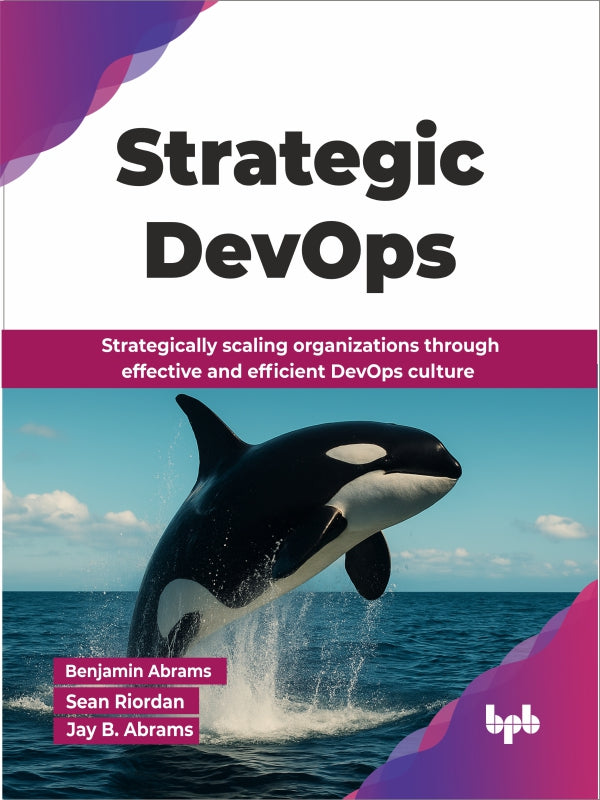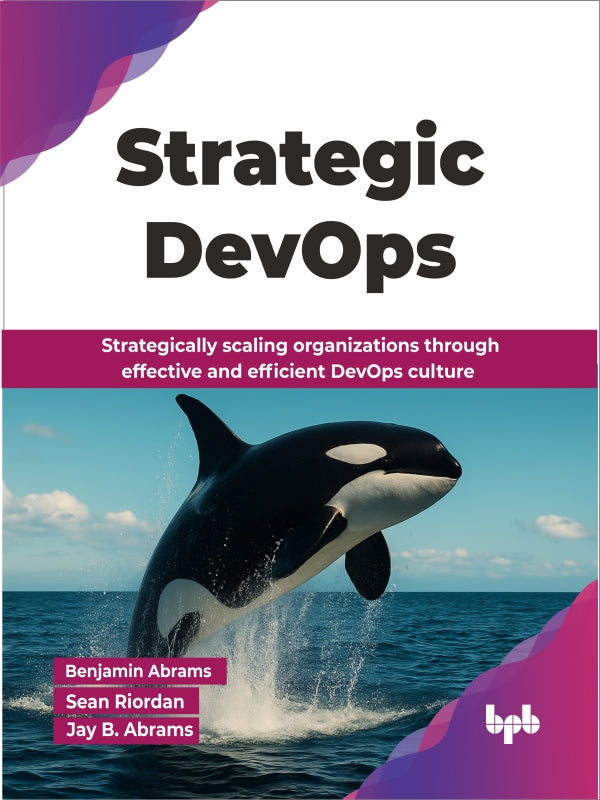Strategic DevOps
Couldn't load pickup availability
ISBN: 9789365892338
eISBN: 9789365899269
Authors: Benjamin Abrams, Sean Riordan, Jay B. Abrams
Rights: Worldwide
Edition: 2025
Pages: 290
Dimension: 7.5*9.25 Inches
Book Type: Paperback

- Description
- Table of Contents
- About the Authors
DevOps is not something you can buy or install, even if some product names might suggest otherwise. This book helps you connect the dots between DevOps culture, technical execution, and business value, offering a practical framework to scale your organization in a world increasingly shaped by rapid change and the growing influence of AI.
While DevOps principles apply broadly, we focus on the developer, operator, and business triad to keep things grounded and actionable. We explore how DevOps culture influences everything from planning and automation to testing, cybersecurity, and observability. Along the way, we take a step back from the technical, asking: what does value actually mean?, and how can DevOps culture create, protect, and scale it?
Scaling technology is easy. Scaling people and culture is the real challenge, and this is where DevOps shines. After reading this book, you will move from mindset to execution, tying culture, metrics, and value together to understand how technical and human systems shape an organization's success.
WHAT YOU WILL LEARN
● Implementing DevOps culture principles.
● Fostering collaboration and breaking organizational silos.
● Automation to development, deployment, and maintenance of a product or service.
● Integrating cybersecurity via shift left/right, threat modeling, and Zero Trust.
● Establishing useful metrics and KPIs for data-driven continuous improvement.
● Implementing observability, monitoring, alerting, and post-mortems for system health.
● Enabling better decision-making in organizations and businesses.
WHO THIS BOOK IS FOR
This book is for engineers, operators, and business leaders seeking to understand and scale value through DevOps culture. With a focus on why, those without a coding background can engage meaningfully, grasping most of the content. The book provides clear and actionable insights into how people, mindset, and culture shape organizational success.
0. Navigation
1. Introduction to DevOps
2. Planning and Reacting to a Changing Organization’s Needs
3. Automation
4. Importance of Automated Testing
5. Security
6. Understanding Pipelines
7. Continuous Integration
8. Continuous Delivery
9. Pipeline Mastery
10. Trusting Our Metrics
11. Valuation, Bridging Management and Engineering
12. Observability
13. This Was Just the Beginning
● Benjamin Abrams was born in San Diego, California, and later became a wandering nomad, traveling throughout the United States, Canada, and Thailand.
Although he attended college during his career, he left to take a good job without completing his degree. He is primarily self-taught. Open-source is part of his DNA; he has contributed to open-source projects throughout his entire career and has served as a maintainer for many of them. If he could speak to what early retirement would look like, he would spend all his work time donatinged to the community. With over a decade of experience, he has gained a unique perspective that motivates him to share his experiences. He began sharing his work publicly through conferences, webinars, and blog posts as early as 2016. He loves discussing automation, operations engineering, security, observability, culture, and scaling teams. He is incredibly grateful that he has had the opportunity to use these experiences to refine his craft before deciding that he wanted to tackle something a bit meatier. These experiences led him to start writing High Performance DevOps. This book has been in the works for a decade; he just needed to decide to write it. He decided to bring along two experts to help deliver the best outcome, which he will introduce shortly.
He looks forward to taking you on a unique journey and providing a fresh perspective on the various cultural and technical aspects of the DevOps philosophy. Before diving into the nitty-gritty or how-to aspects, we will introduce the necessary vocabulary, concepts, and theory for each topic. In each chapter, you can expect us to use real war stories from our experiences to reinforce the topic. We will focus on helping you produce the correct answers rather than providing them for you. We will bring value to various engineering-related personas by carefully weaving themes, concepts, stories, and hands-on exercises that are relevant to their specific needs.
● Sean Riordan was born in Anchorage, Alaska, and received a BS in computer engineering from Montana State University in Bozeman. Fond of ensuring things work as expected, Sean began his career out of college in the oil industry, where he specified safety system instrumentation and developed hardware test plans to ensure their functionality. After moving into software, Sean spent the next ten years writing tests and guiding teams across IoT and health tech on how to build a scalable and performant test suite.
● Jay B. Abrams was born in Los Angeles, CA, and received an MBA from the University of Chicago, where he also took graduate courses in the department of economics. He possesses numerous qualifications that make him the ideal person to address questions related to valuation. He is an Accredited Senior Appraiser (ASA) with the American Society of Appraisers (ASA) and a Certified Public Accountant (CPA) (inactive status). Has been valuing businesses for more than 40 years. Valuation is the science and art of determining the amount an investor should be willing to pay for business ownership or a set of assets. His very first assignment was valuing Columbia Pictures, which was acquired by Coca-Cola in 1982 and later sold to Sony. Thus, he has experience valuing very large and small firms. As a published author in valuation, he has a lot to bring to the table. He has written four books on valuation and more than 20 quantitative journal articles. He invented more than 160 mathematical formulas, valuation models, and algorithms. He can help us provide some missing and much-needed language to bridge the gap between engineering, management, and sales.


